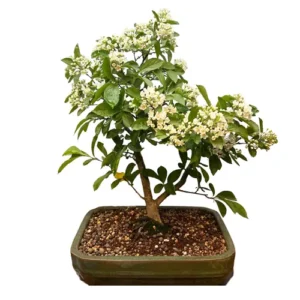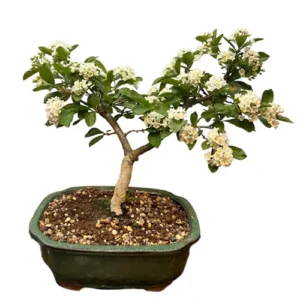Thuja
Northern White Cedar Bonsai
Native to Canada and North America. These evergreen coniferous have found in mountainous regions are distinct for their stringy red-brown bark. While poisonous, its scale leaves and needle-like foliage make a visually arresting bonsai.
Northern White Cedar Bonsai Care Tips
Placement
Thuja appreciates a sunny location during the growing season. At the height of summer shade from hot sun is advised. Strong frost will mean your Thuja needs to be taken into a frost-free greenhouse or similar. These are hardy species but require light during their winter, protected or otherwise.
Watering
As trees are often found on lakeshores in nature, this species requires consistent moisture. Thuja must have its rootball kept slightly moist and must never be allowed to dry out.
Feeding & Fertilising
During the growing season, solid organic feed should be used monthly. Alternatively, a liquid feed can be used on a weekly basis.
Pruning & Wiring
Pruning your bonsai is important not only to create or maintain an aesthetic style but to also ensure optimal health. Pinch new shoots while they are still soft. Heavy pruning should take place towards the end of Autumn. This species can be trimmed and pruned back into the old wood.
Thuja are receptive to wiring all year round. Doing so can improve the branch lines. We recommend using wires with a thickness that matches the thickness of the branch: if the wire you choose is too thick you will damage the bark. If it is too thin, it won’t be effective.
Repotting
Repotting your tree is an important way to provide a fresh and suitable soil mix and ensure appropriate root health. Rept your Thuja every 2-3 years at the opening of Spring. If you have an older Htuja, it can be repotted later than this.
Trees that are ready for repotting will require root pruning, a suitable new pot and appropriate soil mix.
When repotting, do not cut back the root mass by a large amount, and choose a well-draining soil mix that has a neutral or slightly higher PH value of 5-6 but not over 7. We tend to use a mixture of different speciality bonsai soils on our trees. Every species is different so please contact us for free soil-mix advice or to take advantage of our repotting service.
Bonsai trees aren’t only magnificent additions to an indoor oasis, they are more than capable of standing out in any garden. Many Bonsai species are incredibly hardy and withstand nature’s colder and damper turns with aplomb making them worthwhile outdoor plants. We have an extensive library of care guides for outdoor bonsai trees. It’s not about selecting the perfect bonsai, it’s about selecting the perfect bonsai for you.
Northern White Cedar Bonsai - Typical Queries
How to propagate Northen White Cedar bonsai?
Northern White Cedar can be propagated with both seeds or cuttings.
Are Northern White Cedar bonsai prone to pests and diseases?
Northern White Cedar can attract an array of intruders and diseases. Cypress canker, thuja blight, root rot and tip blight can all befall this bonsai. Pests like bagworms, cypress tip miners, arborvitae leaf miners and Japanese beetle are possible attackers. The correct pesticides can address these.
Can you keep a Northern White Cedar bonsai indoors?
As a native species to temperate climates, this is best kept outdoors to provide the aeration and consistent sun this tree demands for growth.





















